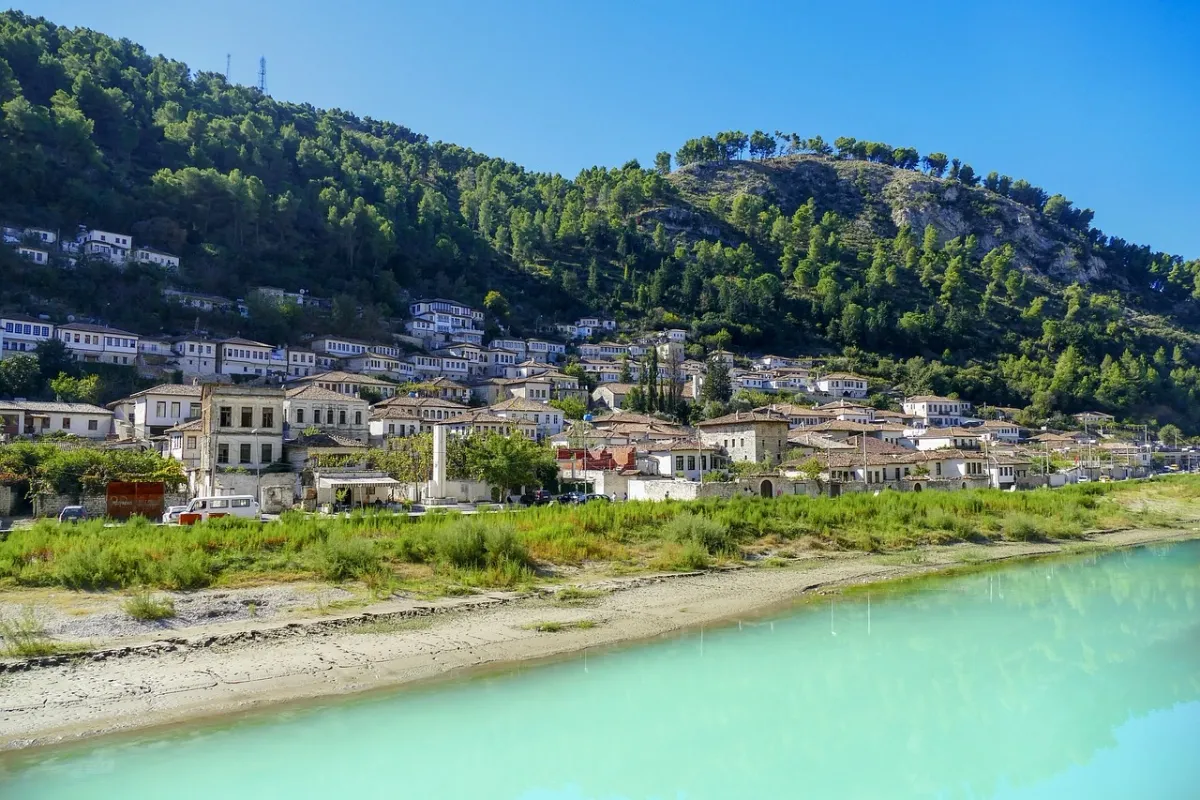When we first did our research—in the fall of 2020 and later in May 2021—we didn’t find much concrete information to help us plan a great trip through Albania.
So, we set off to explore the country with fragments of knowledge and a huge desire to see what it had to offer.
Now, after spending four packed days, driving 250 km on Albanian roads, and walking another 50 km through three of the country's most beautiful cities, we're here to help you with a short travel guide that covers all the essential things you need to know if you're visiting Albania for the first time.
Albania for Beginners – A Short Travel Guide
The first time the idea of exploring Albania crossed our minds was in the summer of 2020. We found some super cheap plane tickets to Tirana for a weekend in December, and our plan at that time was to take a city break in the country’s capital.
Unfortunately, those plans fell through, and we canceled the trip, but we made a promise to ourselves that we would visit Albania the following year. When we canceled the tickets, we thought that maybe December wasn’t the best month to visit Tirana and that we’d visit Albania when the timing was right.
And guess what? We ended up going at just the right time when we needed a getaway that perfectly suited our tastes.
Next, I want to share some important things you need to know if you want to organize a vacation in Albania. We’ll go over aspects such as entry requirements (in both normal and special conditions), transportation, accommodation, internet access, and prices.
Later, in another article, we’ll discuss the itinerary we followed during our four days on Albanian soil.
Road Taxes in Albania
If you enter Albania by land from Kosovo, it’s worth knowing that the stretch of highway (A1) between Kosovo and Tirana is the only road section for which you need to pay a toll of 5 euros. For Albania’s few highways and the rest of its roads, there’s no need to purchase a vignette.
Read also:

Transportation in Albania
Regardless of how you enter Albania or the itinerary you plan for your trip, you’ll need to choose a transportation option that suits your needs.
Here are some tips to help you better plan your trip, along with some stories from our experiences with public transport and a rental car.
Personal/Rental Car
As mentioned, road taxes don’t apply in Albania—except on the A1 highway—so you won’t have to worry about purchasing a vignette. Highways in Albania are almost non-existent—there are only three highways in the country (A1 – 177 km, A2 – 76 km, and A3 – 30 km).
This means that distances between cities take longer to cover, even if they aren’t very far. Additionally, major cities can be reached via expressways, often marked with "SH." Unfortunately, as I mentioned on Instagram and Facebook, information about Albania is scarce and not always up-to-date, which also applies to Google Maps.
In our case, and not only, Google Maps sometimes didn’t recognize certain road sections and directed us onto national roads through villages. This isn’t necessarily a bad thing since these roads are less crowded compared to expressways, but the travel time increases due to lower speed limits.
- Speed limits: On highways, the speed limit is 110 km/h; on expressways, it’s 90 km/h; and on other roads, it’s 40 km/h, while in towns, it’s often 20 km/h.
To rent a car—which I highly recommend if you plan to tour the country—you can use Rental Cars. We always rent cars through Rental Cars (we’ve done so in Mexico, Belgium, Poland, Greece, and Albania) because the cancellation process is very simple, and RC offers full insurance, which not only lets us sleep peacefully but also spares us from paying huge deposits.
In Albania, we rented a car for just 24 hours from Alamo, which cost us 23 euros.
- Fuel: A liter of fuel costs between 150 and 160 LEK.
Public Transport
I should start by saying that public transport in Albania is very cheap, much cheaper than what we’ve found in countries like Greece or Egypt. Relying solely on public transport is not only a unique experience—which might even evoke some nostalgic memories—but also a bit of a hassle.
As I’ve repeatedly mentioned, you won’t find much information online, maybe just bits and pieces to cling to, and you’ll have to rely heavily on the locals. You simply have to trust that they’ll help you, understand what you want, and that, with a bit of luck, you’ll reach your destination.
Public transport in Albania isn’t like in London or Barcelona. On Google Maps, you won’t find the routes or station names, and on-site, you’ll find old buses, unmarked stations, and people who don’t speak English. For us, it was the kind of experience we had to try.
Traveling around the city by bus is extremely cheap. A single ride costs 0.40 LEK , and you buy your ticket directly on the bus. Usually, each bus has a ticket inspector who, once the bus reaches a station, shouts the name of the final destination and then goes to each passenger to sell the tickets.
Due to the lack of information (possibly), we didn’t see too many tourists using the bus. In fact, in both cases, we were the only tourists, the only strange ones who didn’t speak Albanian.
Our first bus ride was to the bus station where buses to Durres (in our case) and other cities (Vlore, Berat, Shkodra) depart from. We didn’t know exactly where to get off, but we knew which direction to go. The inspector helped us and told us when to get off.
Read also:

For a bit of orientation when it comes to urban transport, you can use the Moovit app alongside Google Maps. All you need to know is your departure station and the area you want to reach, then follow the bus’s movement on the map. It’s not rocket science! 😀
If you want to travel between cities by public transport, if you’re traveling on a budget or looking for a bit of adventure, Albania is the place to be. Once you arrive at the bus station in Tirana, you’ll see a multitude of buses and minibusses preparing to leave for all the major and minor cities in the country.
It’s a chaotic scene with drivers shouting the names of the cities their buses are heading to, cars parked on the side, and honking everywhere.
Intercity travel is just as cheap. The trip from Tirana to Durres cost us 150 LEK per person, and a trip from Tirana to Berat costs around 250-300 LEK (or so we heard). Usually, you pay the driver either when you board or when you get off.
How to get from Tirana to Durres by bus?
The bus station in Tirana is in the center (see location on the map). From the center, you take the bus that goes to Instituti and ask the inspector to tell you when you reach Dogana (which means "bus to Durres").
You get off at the bus station, and if you’re paying attention, you’ll see the location through the window. Then you start looking left and right for the bus or minibus that goes to Durres. Go to the driver, ask how much it costs and when it leaves, and 40 minutes later, you’ll be in Durres.
Using public transport made our vacation even more interesting and, in a way, reminded me of childhood summers. It was a true experience, and if you travel like we do, I encourage you to try this mode of transport as well.
Airport Transfer
Tirana Airport is relatively close to the city center, about 15 km away. For the airport transfer, there are three options:
- Rental car: As mentioned, for a hassle-free road trip, a car is the best solution.
- Taxi: Although Albania is a super cheap country, taxis are relatively expensive. Airport rides have a standard price of 15-20 euros.
- Bus: Upon exiting the airport, after passing the rental car stands, you’ll see minibusses heading to Tirana, Vlore, or Durres. There is only one bus per hour, usually departing on the hour, and a trip to the city center costs 300 LEK . Similarly, the bus departs from the city center at fixed times, which are displayed at the station (I've marked the station on the map). If you have enough time (the buses don't run at night) and don't have a rental car, the bus is a good option to consider. Travel time is similar to that of a taxi, taking about 30 minutes.
Internet
You probably already know that roaming charges are high in countries outside the European Union. To avoid getting hit with a hefty bill, it's important to turn off your mobile data as soon as you leave the European Union.
Once you arrive in Albania, at the airport or your first stop, you can easily buy an internet SIM card. We bought one from Vodafone at Tirana Airport, which had 3 GB of data, plus a certain number of national minutes and SMS, for 12 euros.
Accommodation
When we left home, we set a budget of 40 euros per night, not knowing that we'd end up paying even less. As we’ve done since last year, we booked our accommodation in Albania last minute, on the day we arrived. Our time was split as follows: 3 nights in Tirana and 2 in Durres.
Although the hotels were three-star, they were far from perfect. We have to admit that! All the hotels excelled in cleanliness, staff, and location, but not in soundproofing, which is extremely important to us.
Read also:

In terms of prices, for 4 nights of accommodation, we spent 116 euros for 2 people, and the hotels we chose were:
- Areela Boutique Hotel Tirana – 30 euros/night for a double room.
- VH Belmond Hotel Durres – 22 euros/night for a double room with breakfast included.
- Hotel Vila e Arte City Center Tirana – 32 euros/night for a double room (we stayed here for 2 nights).
Final Thoughts
This has been our beginner’s guide to traveling in Albania. I hope this guide sheds some light on how you can travel through Albania on your own.
If you have any other questions, feel free to leave them in the comments section. And if you need a little inspiration, follow us on Instagram.
Until next time, I invite you to read some curiosities about Albania!



